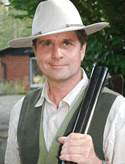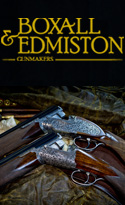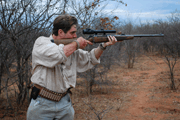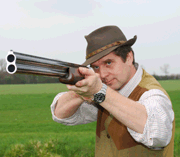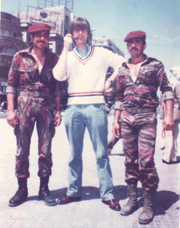Gun Fit Part II
In the last part we considered drop and length, in this part we will begin by considering cast. It is the extent to which the stock is angled to the left (cast-on) or right (cast-off) and is an especially important variable of gunfit to those who have less than absolute eye dominance or have a body shape which does not conform to the 'Mr. Average' norm. Cast is usually measured at heel and toe, typical dimensions would be 1/8" and 3/16" respectively (though guns may be much more heavily cast in some cases). The need for a difference in the cast dimensions at heel and toe is explained by human anatomy: the bulk of the chest calls for the sole of the stock to be slightly angled to achieve firm and comfortable support. That said, some factory made guns are built without any cast at all (and, with these, the only way one may get the eye in line with the rib is by tilting the head).
Usually a right-handed shot has a cast-off stock (i.e. one cast to the right) and a left hander, one that is cast-on. Those with broad chests may want more cast than average, and it can also be used to accommodate differences in facial width and type (a right-hander with wide spaced eyes may occasionally be accommodated by cast-on normally reserved for southpaws). In fitting for cast, it must be understood that it is not simply a question of getting the eye precisely aligned with the rib in the horizontal plane (though this may be used as a starting point for fitting). Some people will need very considerable cast because of eye dominance anomalies; the extreme being those who need a stock with a distinct dogleg in it to compensate for the effects of cross-dominance or central vision. In many of these cases the eye will be no where near the centre line of the rib. Many more may need 1/8 or 1/4" extra at heel to compensate for a left eye which is having the effect of pulling the aim off target slightly. Cast (and the need for it) may be tested at the pattern plates and on straight driven and going-away targets. Quartering birds can also be useful in this context.
Cast should always be kept to the absolute minimum required. It can increase felt recoil; it puts more strain on a weak area of the stock (the wrist), and in its extremes can also hinder natural gun pointing. Cast also has the effect of dropping the head (adding cast may require you to raise the stock as well). I particularly dislike seeing extremes of cast on over and unders. An alternative or supplement to cast is to offset the comb. One often sees the combination of offset and cast on bespoke guns. This allows for cast at heel to be substantially reduced. Very thick combs, as seen on some Italian trap guns may unintentionally push the eye to the left of the rib. A simple cure for this is to carefully thin the comb or to fit an adjustable comb and offset it slightly. Sometimes, one sees guns in which the comb has been 'swept' or 'scooped' as a means of altering eye-rib relationship without increasing cast. If one looks at the side of the comb on such guns, a concave curve or depression will be seen in the side of the stock.
As with drop, cast affects the positioning of the gun at the shoulder. It is often said that the butt sole should sit in the so-called "shoulder pocket" located between shoulder joint and collarbone. I do not accept this as an absolute rule. For some it is the right place, but, many first class shots mount the gun on or near the shoulder joint and would be uncomfortable doing other wise. It depends on the shape of one's upper body and one's style of mounting and the discipline being shot. What is absolutely wrong is to mount the gun on the upper arm. This is a frequent error and results in the butt being insufficiently and inconsistently supported; bruising is a common result.
We have not yet said much about pitch (sometimes called 'stand'). The length of the stock from the middle of the trigger to the heel and the toe control the pitch of a gun and, when taken together with the length of pull, the shape of the butt sole too. Pitch concerns the angle of the of the butt sole relative to the axis of the rib and may be measured approximately by standing the gun against a wall, with the top of the action touching it's surface and the butt sole against the floor (make sure that the wall is truly perpendicular to the floor). If you are really keen, pitch can be measured in degrees in a specialist jig (measuring in this fashion is more precise because barrel length does not affect the result). Typically, the measurement is about 2" 'pitch down' on a sporting clays or skeet gun, but may be significantly less on a dedicated trap gun (which, of course, is intended exclusively for rising targets). Some trap guns may even have positive pitch). The pitch measurement is also important on a hunting gun. In live quarry shooting, there is a need to keep well up on line as the swing progresses. The right pitch dimension will facilitate this and makes rising and crossing shots in the field significantly easier.
Rather than encouraging you to get protractors out, I would say that the simple rule for pitch is to create a stock in which the surface of the butt sole is in comfortable full-length contact with the shoulder when the gun is mounted and in which there is no unwanted tendency for the barrel to point up or down relative the line of sight. If the toe or heel of the butt sole or its centre are not in firm contact with the shoulder, or, if the pitch measurements cause the butt sole to catch or slip at the shoulder something is clearly wrong. When the gun is mounted, watch to see if the heel or toe are coming to the shoulder first. Temporary adjustments to pitch can easily be made to guns with butt plates or recoil-pads by loosening off the screws and introducing shims. Women and men with large chests may want a reduced toe measurement and, often, a rounded toe as well.
One of my approximate tests for pitch involves asking the client to point a proven empty gun at my eye from a range of about 15 feet [this is not something I do lightly or without stringent safety procedure]. As a starting point for experiment, what I want to see is the striker/firing pin hole well centred in the circle of the muzzles as I look down them (which is indicative that the gun is not tipping up or down relative to the line of sight). In case you think that this sounds rather difficult, I might add that, provided you are standing with some light behind you, it is usually surprisingly easy to see the breechface and striker hole from the muzzle end of the gun - even if you are some distance away.
The curve of the butt sole should also match the shoulder and mounting technique of the user. Someone who mounts the gun on the shoulder joint wants a curved sole to match the shape of it (whatever they may be shooting - skeet, sporting or live birds). Someone who mounts in the 'shoulder pocket' or lower, on the chest, wants an entirely different shape to achieve consistent support. When I am custom fitting guns, I ignore the normal designations on pads such as "trap", "skeet" or "sporting". The individual's body shape and his or her technique are much more important. Often I will use a trap pad in a sporting gun. In fact, the occasions when I use a flat pad are rare (I meet few cleints with a flat shoulder).
Grip shape is another important variable of gun fit. The grip must be so formed that the wrist is not obliged to be excessively cocked, it must be wide enough in circumference, and not excessively rounded in cross section (most are oval or diamond shaped) to achieve adequate purchase and gun control. Any grip which narrows to its front (i.e. a grip which is not even in depth front to rear, but rather goes from a thick rear to a thin front) may encourage the hand to slip forward in recoil. Such grips - and there are a lot of them out there - are poorly designed. A grip for sporting clays or hunting where the gun, when used well, should be pushed towards the bird (with the shoulder coming forward to meet the gun) wants to be less acutely angled than a grip for a trap shot who prefers to pull the gun back to his shoulder during the mount. [The most extreme example of the pulling grip is the hooked type made famous by Fred Etchen.]
Any grip must not only be the right shape, it must compliment the size of the palm and length of fingers. Palm swells are fine on trap guns IF they fit the shape of the users hands. Otherwise they are a hinderance to good shooting. Generally, I do not advise their use for skeet or sporting. The position of the nose (front) of the comb is important in all cases, if it is too far forward (a common failing of mass produced guns) the hand is unable to take up a comfortable, effective, position. The nose is easily brought back by a competent gunsmith who may also choose to change the shape of the flutes beneath the nose to suit the individuals hand. Often, it is not so much a case of poor fit, but of poor design initially - many of the grips on factory produced guns fit no human hand. Finally, we might note that trigger pulls must also 'fit' the user and the weight of the gun. A first pull of about 3-3 1/2 pounds and a second pull 1/2 pound heavier is about right for the average competition 12 bore (excessively light, heavy or inconsistent pulls can cause real problems). It goes without saying that triggers must break cleanly without creep and the trigger blades themselves should be well shaped to suit the individual.
ALWAYS HANDLE A GUN AS IF IT WERE LOADED
The term 'balance' covers all sorts of imponderables but let's keep it simple. If the gun is grossly barrel or stock heavy, as measured using the hinge pin as a fulcrum (assuming a break action gun), you are - in most circumstances - not going to do your best shooting. It is all too common to see guns beautifully lengthened or fitted with recoil pads or recoil reducing devices in which no attempt has been made to restore balance. Many mass produced guns, especially those with multi-chokes, are too muzzle heavy when they leave the factory. This is because modern barrels tend to be fairly thick to accomodate multi-chokes and modern wood tends to be quite open grained and light. To counteract this, weight may be introduced into the back of the gun by means of lead or lead shot and putty. With fixed choke guns, back-boring or rib modification may reduce barrel weight, although it worth noting that barrels, even long ones, can be made too light. What most people want is a gun which is lively but not wild.
Sometimes one needs to reduce stock weight, in which case the stock may be hollowed by drilling or internal carving. There are, morevover, all sorts of weights that one can buy to attach to barrels, place in mag tubes or insert into stocks to create a muzzle heavy balance. Balance is a very personal business. My advice is to avoid extremes. Barrel weight and balance are especially critical factors in trap guns (faster disciplines usually benefitting from lighter barrels). In a skeet gun one can get away with (and even benefit) from muzzle heaviness (especially if the gun is being used premounted). Such a balance may encourage a smooth follow through. For sporting clays, my preference is for light, but long barrels and a near hinge pin balance. I prefer fixed choke barrels for sporting because they tend to be lighter. For hunting, a hinge pin balance and light barrels of about 28" would be my ideal (I also like the weight to be concentrated in the centre region of the gun if it is to be used for live birds). Very short barrelled guns tend to be too quick (rushing is one of the commonest of all shooting errors whether consider game or clays). Alterations to balance can profoundly effect the way a gun handles and may effect apparent weight. A heavy, well-balanced, gun is vastly superior to a lighter ill-balanced one.


